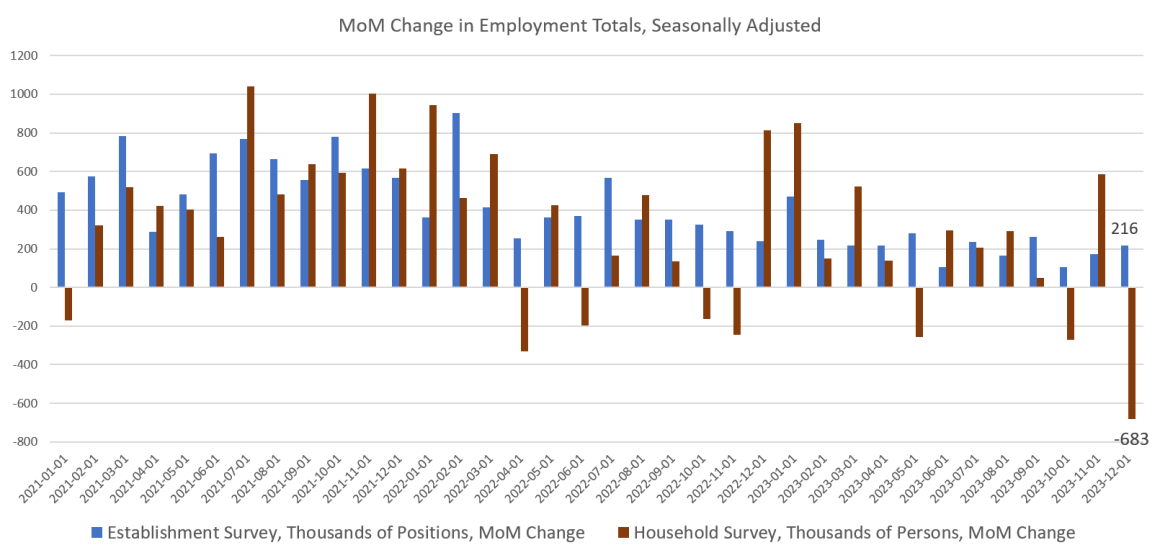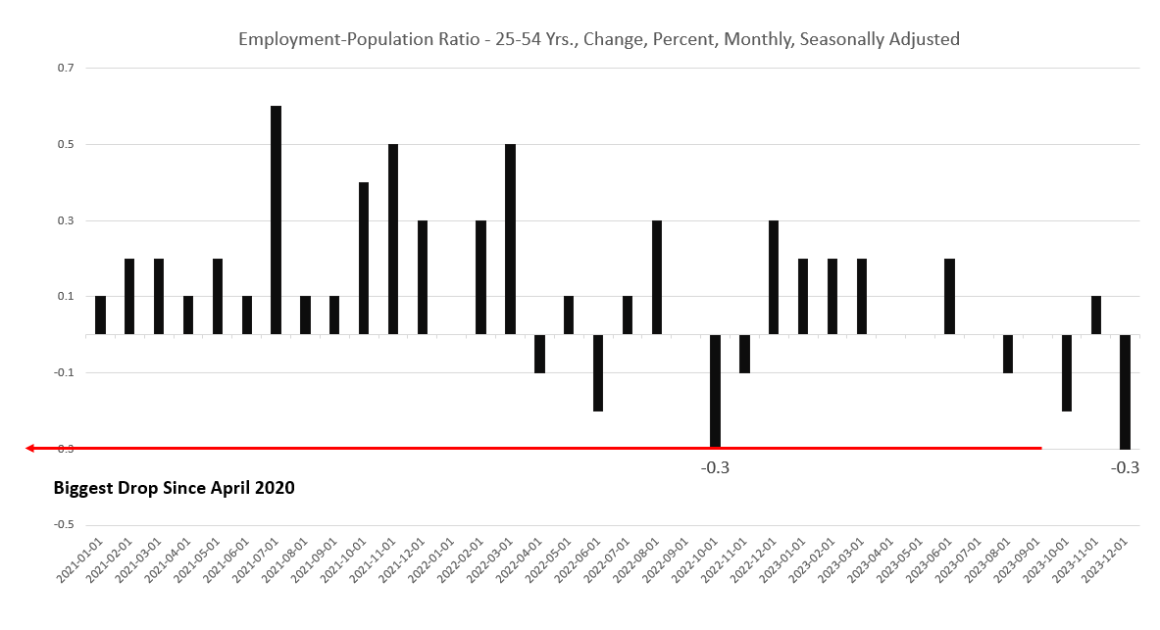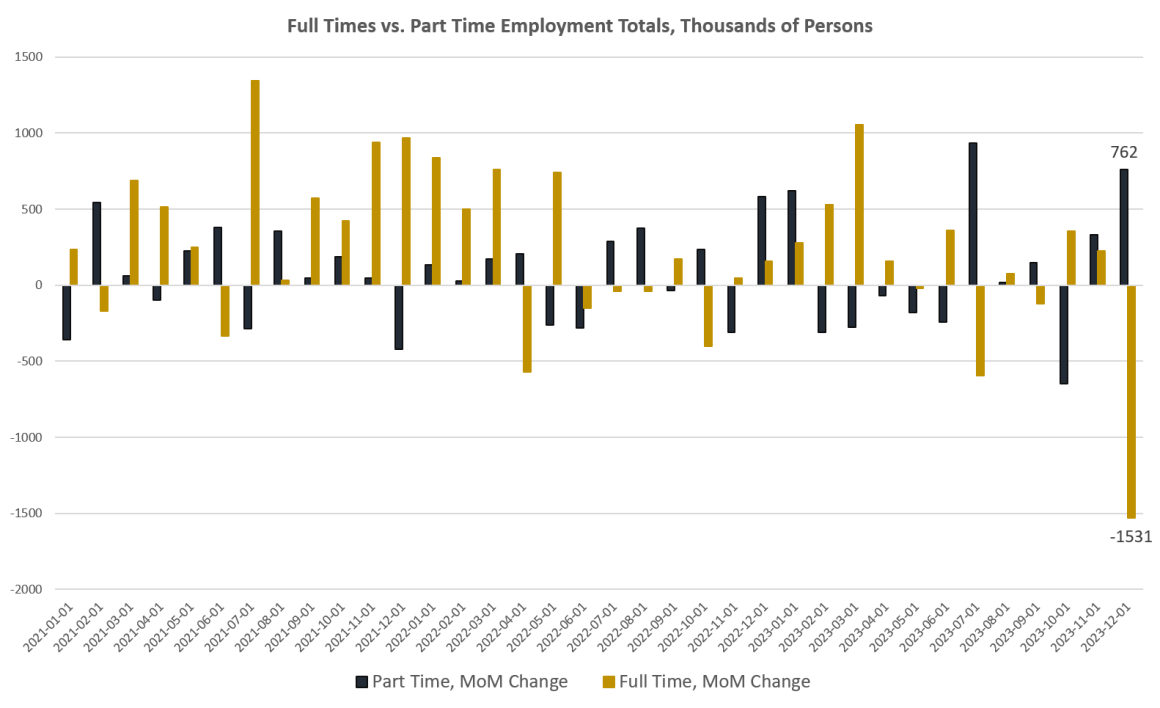According to a new report from the federal government's Bureau of Labor Statistics last Friday, the US economy added 216,000 jobs for the month while the unemployment rate held at 3.7%. NBC news was sure to tell us that this "beat expectations." Market estimates suggested total jobs added at 170,000 with the unemployment rate at 3.8%. The media's general consensus on the report is that the jobs economy is "robust" and everything is heading on schedule toward a "soft landing" as predicted by Federal Reserve economists. What are we to make of this report? Well, the jobs market looks pretty good so long as one doesn't dig any deeper than the first paragraph of the press release. But once we look more carefully as numerous indicators of employment as found in part
Topics:
Ryan McMaken considers the following as important: 6b) Mises.org, Featured, newsletter
This could be interesting, too:
RIA Team writes The Importance of Emergency Funds in Retirement Planning
Nachrichten Ticker - www.finanzen.ch writes Gesetzesvorschlag in Arizona: Wird Bitcoin bald zur Staatsreserve?
Nachrichten Ticker - www.finanzen.ch writes So bewegen sich Bitcoin & Co. heute
Nachrichten Ticker - www.finanzen.ch writes Aktueller Marktbericht zu Bitcoin & Co.
According to a new report from the federal government's Bureau of Labor Statistics last Friday, the US economy added 216,000 jobs for the month while the unemployment rate held at 3.7%. NBC news was sure to tell us that this "beat expectations." Market estimates suggested total jobs added at 170,000 with the unemployment rate at 3.8%. The media's general consensus on the report is that the jobs economy is "robust" and everything is heading on schedule toward a "soft landing" as predicted by Federal Reserve economists.
What are we to make of this report? Well, the jobs market looks pretty good so long as one doesn't dig any deeper than the first paragraph of the press release. But once we look more carefully as numerous indicators of employment as found in part time jobs, inflation-adjusted wages, and more, we find that things aren't looking so good after all.
But first, let's ask ourselves if this government data is reliable at all. Well, it's always been a good idea to take the federal government's economic reports with many healthy grains of salt. But, they have historically been at least plausible in terms of providing some insights into the state of the macro economy. Over the past two years, however, the government's headline employment numbers—usually reported as a number of jobs gained for the previous month—have become nearly useless in gaining a detailed picture of where employment is headed.
The reports can still be useful in some ways if one digs down beneath the surface of the headline number. One can find some plausible data that gives us some hints about job trends. but it's now at the point where one has to wait months until the data has been revised to get beyond "the propaganda number." This is because over the past year, the federal number crunchers have increasingly reported jobs data that shows jobs total well above the later revised data. The more believable numbers only appear when the federal number crunchers revise down the numbers after the media has moved on to other topics.
One can't prove that the government economists intend to mislead with these numbers, but the consistency with which the jobs numbers just happen to be better than the reality almost every month should strike one as rather suspicious.
This isn't something that just a bunch of anti-Biden activists noticed. Earlier this week, for example, Marketwatch reported on how jobs numbers were repeatedly exaggerated in 2023:
[T]he official U.S. employment reports chronically overstated how many jobs were created each month in 2023, potentially misleading Wall Street, the Federal Reserve and Washington lawmakers about the true strength of the economy.
From January to October, the government initially overestimated job growth in nine of the 10 months. Eventually the employment gains were reduced by an average of 55,000 a month, an unusually large change.
Take last June as an extreme example. The government initially said a robust 209,000 new jobs were created before marking its finally estimate down to a tepid 105,000 two months later.
A revision of 104,000 jobs is a big deal, and it illustrates how pre-revision numbers have drifted in the direction of reading more and more like a Soviet report on economic growth.
Thanks to the existence of private research firms and private-sector economists who analyze and report their own (albeit more localized) data, the government can't just report whatever they want. They have to maintain some level of plausibility. Thus, it's still possible to find some usable information if we know what we're looking for. Given the federal report-makers' apparent commitment to inflating the numbers, however, it's bad news when we can still find so much negative data on job trends in the reports.
Total Employed Persons Fell at the Worst Pace Since Covid
The headline number reported by all the news outlets is usually the "establishment survey" number which is a total number of payroll positions. It's not a total number of employed individuals.
The unrevised number of December did indeed show an increase of 212,000 positions for December (month-over-month). That's a respectable number, historically speaking. That would be great were it not for the results we see from the other employment survey, the household survey. The household survey is a survey of individuals, and they're asked if they're employed. Thanks to multiple job holders, the total number of jobs can increase even while the number of employed people falls.
A look at the household survey shows that the month-over-month change in employed persons for December was the worst since the Covid recession. Specifically, 683,000 fewer people were employed in December than in January. That's seasonally adjusted. We have to go back to April 2020, when much of the country was still in "lockdown mode" to find a worse number. In other words, employment, as measured by the household survey was a big disappointment in December.
But what about that solidly good unemployment rate? It held steady at 3.7 percent according to the headline numbers. So how did the unemployment not go up as so many fewer people were employed?
The answer lies in the fact that a lot of people left the work force. To be in the work force, one must either have a job or actively want a job. Once you decide to stop looking for work, you're out of the work force. In December, the civilian work force fell by 676,000 people, as discouraged workers gave up, older people retired early, or workers stopped seeking employment for whatever reason. That helps push up the unemployment rate since the rate is calculated as a percentage of the total active work force that is employed.
To get a sense of how many prime age people are leaving the work force, we can also look at the employment-population ratio for people aged between 25-54. This is how many people are employed as part of the population overall. In December, the prime-age ratio fell by 0.3 percent. That's tied with October 2022 as the biggest drop since Covid.
So long as that sort of thing keep up, the economy can continue to lose hundreds of thousands of jobs without an increase in the unemployment rate.
Part-Time Work Replaced Full-Time
Another indicator of the jobs situation being less than rosy is loss of full-time jobs in the report. According to the household survey, we already know that the total number of employed persons went down. Interestingly, however, the total number of people with part-time jobs went up by an impressive 762,000. Unfortunately, the number of employed people with full-time jobs fell by 1.6 million. Once again, that's the worst decline we've seen in full-time employment since the Covid recession.
Inflation Keeps Real Wages Flat
But at least people have jobs and their wages are going up, right? Well, sort of. Year- over year, the inflation-adjusted average hour wage did increase by 0.8 percent for December. That's moderately good. But the current period of growth comes only after 25 months in a row of year-over-year declines in real wages that workers endured from mid-2021 to mid-2023. We also find that the average hourly wage has increase by a mere 0.76% over the past four years. For the four year period from 2016 to 2020, in contrast, real average hourly wages increased by more than three times as much, rising 2.8 percent. Keep in mind, also, that the increase of 0.76 percent over the past four years is inflation-adjusted using the CPI. So, if CPI growth underestimates actual price growth for ordinary people even a little bit—which is a safe bet—then the average earnings are actually down or flat since late 2019. That's not exactly a success story for average wages.
Why Haven't There Been More job Losses?
The jobs situation can perhaps best be described as mediocre. It's clearly not "robust" or strong" as the media would have us believe. There are too many people losing full-time jobs and leaving the work force for that to be the case. On the other hand, it's also fairly clear that most people still have jobs, even if mass layoffs are starting to bite a bite more.
Yet, many more astute observers are likely asking themselves why employment is still so good more than eighteen months after the Federal Reserve started letting interest rates rise significantly for the first time in more than a decade. For people familiar with Austrian Business Cycle Theory, an economy of easy-money-fueled bubbled ought to unravel once the central bank—motived purely by the political costs of inflation—is forced to let rates rise.
Why isn't there more evidence of this happening in the form of job losses? The answer is largely in the monetary overhang. The economy has still not recovered from more than two years of runaway monetary inflation. A lot of that money is still out there propping up zombie companies. Moreover, financial conditions, even today, haven't tightened up as much as many assume. In last week's episode of the Radio Rothbard podcast, economist Daniel Lacalle explained how the effects of immense amounts of monetary inflation are still wearing off. Banks are still pumping liquidity thanks to a series of back-door bailouts that are keeping banks in business in spite of their underwater portfolios.
Many corners of the boom portion of the current cycle have not yet given way to the bust. The job market is still hanging on—but not nearly as well as the headline numbers and media pundits would have you believe.
Tags: Featured,newsletter




